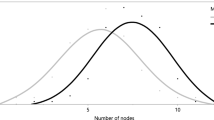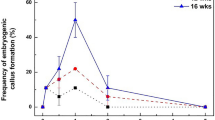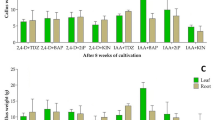Abstract
Methods described in this paper are confined to in vitro dedifferentiated plant cell suspension cultures, which are convenient for the large-scale production of fine chemicals in bioreactors and for the study of cellular and molecular processes, as they offer the advantages of a simplified model system for the study of plants when compared with plants themselves or differentiated plant tissue cultures. The commonly used methods of initiation of a callus from a plant and subsequent steps from callus to cell suspension culture are presented in the protocol. This is followed by three different techniques for subculturing (by weighing cells, pipetting and pouring cell suspension) and four methods for growth measurement (fresh- and dry-weight cells, dissimilation curve and cell volume after sedimentation). The advantages and disadvantages of the methods are discussed. Finally, we provide a two-step (controlled rate) freezing technique also known as the slow (equilibrium) freezing method for long-term storage, which has been applied successfully to a wide range of plant cell suspension cultures.
This is a preview of subscription content, access via your institution
Access options
Subscribe to this journal
Receive 12 print issues and online access
$259.00 per year
only $21.58 per issue
Buy this article
- Purchase on Springer Link
- Instant access to full article PDF
Prices may be subject to local taxes which are calculated during checkout













Similar content being viewed by others
References
Endreß, R. Plant Cell Biotechnology (Springer-Verlag, 1994).
Dixon, R.A. Isolation and maintenance of callus and cell suspension cultures. In Plant Cell Culture; a Practical Approach (ed. Dixon, R.A.) 1–20 (IRL Press, 1985).
Gamborg, O.L. & Phillips, G.C. Media preparation and handling. In Plant Cell, Tissue and Organ Culture; Fundamental Methods (eds. Gamborg, O.L. & Phillips, G.C.) 1–90 (Springer Lab Manual, Springer-Verlag, 1995).
Morris, P. Long term stability of alkaloid productivity in cell suspension cultures of Catharanthus roseus. In Secondary Metabolism in Plant Cell Cultures (eds. Morris, P., Scragg, A.H., Stafford, A. & Fowler, M.W.) 257–262 (Cambridge University Press, 1986).
Sierra, M.I., van der Heijden, R., van der Leer, T. & Verpoorte, R. Stability of alkaloid production in cell suspension cultures of Tabernaemontana divaricata during long-term subculture. Plant Cell Tiss. Org. Cult. 28, 59–68 (1992).
Hulst, A.C., Meyer, M.M.T., Breteler, H. & Tramper, J. Effect of aggregate size in cell-cultures of Tagetes-patula on thiophene production and cell growth. Appl. Microbiol. Biotechnol. 30, 18–25 (1989).
Edahiro, J.-I. & Seki, M. Phenylpropanoid metabolite supports cell aggregate formation in strawberry cell suspension culture. J. Biosci. Bioeng. 102, 8–13 (2006).
Su, W.W. & Arias, R. Continuous plant cell perfusion culture: bioreactor characterization and secreted enzyme production. J. Biosci. Bioeng. 95, 13–20 (2003).
Ten Hoopen, H.J.G., van Gulik, W.M. & Heijnen, J.J. Continuous culture of suspended plant cells. In Vitro Cell Dev. Biol. 28, 115–120 (1992).
Schripsema, J., Meijer, A.H., van Iren, F., ten Hoopen, H.J.G. & Verpoorte, R. Dissimilation curves as a simple method for the characterization of growth of plant cell suspension cultures. Plant Cell Tiss. Org. Cult. 22, 55–64 (1990).
Stafford, A., Smith, L. & Fowler, M.W. Regulation of product synthesis in cell cultures of Catharanthus roseus (L)G. Don. Plant Cell Tiss. Org. Cult. 4, 83–94 (1985).
Blom, T.J.M., Kreis, W., van Iren, F. & Libbenga, K.R. A non-invasive method for the routine-estimation of fresh weight of cells grown in batch suspension cultures. Plant Cell Rep. 11, 146–149 (1992).
Contin, A., van der Heijden, R., ten Hoopen, H.J.G. & Verpoorte, R. The inoculum size triggers tryptamine or secologanin biosynthesis in a Catharanthus roseus cell culture. Plant Sci. 139, 205–211 (1998).
Schripsema, J. & Verpoorte, R. Novel techniques for growth characterization and phytochemical analysis of plant cell suspension cultures. J. Nat. Prod. 58, 1305–1314 (1995).
David, H., Laigneau, C. & David, A. Growth and soluble proteins of cell cultures derived from explants and protoplasts of Pinus pinaster cotyledons. Tree Physiol. 5, 497–506 (1989).
Hahlbrock, K. Further studies on the relationship between the rates of nitrate uptake, growth and conductivity changes in the medium of plant cell suspension cultures. Planta (Berl.) 124, 311–318 (1975).
Hahlbrock, K., Ebel, J. & Oaks, A. Determination of specific growth stages of plant cell suspension cultures by monitoring conductivity changes in the medium. Planta (Berl.) 118, 75–84 (1974).
Taya, M., Hegglin, M., Prenosil, J.E. & Bourne, J.R. On-line monitoring of cell growth in plant tissue cultures by conductometry. Enzyme Microb. Technol. 11, 170–176 (1989).
Thom, M., Maretzki, A., Komor, E. & Sakai, W.S. Nutrient uptake and accumulation by sugarcane cell cultures in relation to the growth cycle. Plant Cell Tiss. Org. Cult. 1, 3–14 (1981).
Bradford, M.M. A rapid and sensitive method for the quantification of microgram quantities of protein utilizing the principle of protein-dye binding. Anal. Biochem. 72, 248–254 (1976).
Doležel, J., Greilhuber, J. & Suda, J. Estimation of nuclear DNA content in plants using flow cytometry. Nat. Protoc. 2, 2233–2244 (2007).
Pfosser, M., Magyar, Z. & Bőgre, L. Cell cycle analysis in plants. In Flow Cytometry with Plant Cells (eds. Doležel, J., Greilhuber, J. & Suda, J.) 323–347 (Wiley-VCH, 2007).
Widholm, J.M. The use of fluorescein diacetate and phenosafranin for determining viability of cultured plant cells. Stain Technol. 47, 189–194 (1972).
Baker, J.C. & Mock, N.M. An improved method for monitoring cell death in cell suspension and leaf disc assays using evans blue. Plant Cell Tiss. Org. Cult. 39, 7–12 (1994).
Verleysen, H., Samyn, G., Van Bockstaele, E. & Debergh, P. Evaluation of analytical techniques to predict viability after cryopreservation. Plant Cell Tiss. Org. Cult. 77, 11–21 (2004).
Deus-Neumann, B. & Zenk, M.H. Instability of indole alkaloid production in Catharanthus roseus cell suspension cultures. Planta Med. 50, 427–431 (1984).
Kartha, K.K. Meristem culture and germplasm preservation. In Cryopreservation of Plant Cells and Organs (ed. Kartha, K.K.) 115–134 (CRC Press, 1985).
Benson, E.E. Cryopreservation of phytodiversity: a critical appraisal of theory & practice. Crit. Rev. Plant Sci. 27, 141–219 (2008).
Schrijnemakers, E.W.M. & Van Iren, F. A two-step or equilibrium freezing procedure for the cryopreservation of plant cell suspensions. In Methods in Molecular Biology Vol. 38 Cryopreservation and Freeze-drying Protocols (eds. Day, J.G. & McLellan, M.R.) 103–111 (Humana Press, 1995).
Reinhoud, P.J., Van Iren, F. & Kijne, J.W. Cryopreservation of undifferentiated plant cells. In Cryopreservation of Tropical Plant Germplasm: Current Research Progress and Application (eds. Engelmann, F. & Takagi, H.) 91–102 (International Plant Genetic Resources Institute, 2000).
Bachiri, Y.C., Gazeau, J., Hansz, J., Morisset, C. & Dereuddre, J. Successful cryopreservation of suspension cells by encapsulation-dehydration. Plant Cell Tiss. Org. Cult. 43, 241–248 (1995).
Yamazaki, H., Ayabe, K., Ishii, R. & Kuriyama, A. Desiccation and cryopreservation of actively-growing cultured plant cells and protoplasts. Plant Cell Tiss. Org. Cult. 97, 151–158 (2009).
Steponkus, P.L., Langis, R. & Fujikawa, S. Cryopreservation of plant tissues by vitrification. In Advances in Low Temperature Biology Vol. 2 (ed. Steponkus, P.L.) 1–62 (JAI Press, 1992).
Sakai, A., Hirai, D. & Niino, T. Development of PVS-based vitrification and encapsulation-vitrification protocols. In Plant Cryopreservation: A Practical Guide Chapter 3 (ed. Reed, B.M.) 33–57 (Springer, 2008).
Langis, R., Schnabel, B., Earle, E.D. & Steponkus, P.L. Cryopreservation of Brassica campestris L. cell suspensions by vitrification. Cryo-Lett. 10, 421–428 (1989).
Uragami, A., Sakai, A., Nagai, M. & Takahashi, T. Survival of cultured cells and somatic embryos of Asparagus officinalis cryopreserved by vitrification. Plant Cell Rep. 8, 418–421 (1989).
Dereuddre, J., Scottez, C., Arnaud, Y. & Duron, M. Resistance of alginate-coated axillary shoot tips of pear tree (Pyrus communis L. cv. Beurré Hardy) in vitro plantlets to dehydratation and subsequent freezing in liquid nitrogen: effects of previous cold hardening. Comptes Rendus de l'Académie des Sciences 310 Série III, 317–323 (1990).
Withers, L.A. & King, P. A simple freezing unit and routine cryopreservation method for plant cell cultures. Cryo-Lett. 1, 213–220 (1980).
Škrlep, K. et al. Cryopreservation of cell suspension cultures of Taxus x media and Taxus floridana. Biol. Plant. 52, 329–333 (2008).
Reed, B.M. Cryopreservation; practical consideration. In Plant Cryopreservation: A Practical Guide Chapter 1 (ed. Reed, B.M.) 3–13 (Springer, 2008).
Heine-Dobbernack, E., Kiesecker, H. & Schumacher, H.M. Cryopreservation of dedifferentiated cell cultures. In Plant Cryopreservation: A Practical Guide Chapter 8 (ed. Reed, B.M.) 141–176 (Springer, 2008).
Reinhoud, P.J., Schrijnemakers, E.W.M., van Iren, F. & Kijne, J.W. Vitrification and a heat-shock treatment improve cryopreservation of tobacco cell suspensions compared to two-step freezing. Plant Cell Tiss. Org. Cult. 42, 261–267 (1995).
Ishikawa, M. et al. Effect of growth phase on survival of Bromegrass suspension cells following cryopreservation and abiotic stresses. Ann. Bot. 97, 453–459 (2006).
Lu, T.G. & Sun, C.S. Cryopreservation of millet (Setaria italica L.). J. Plant Physiol. 139, 295–298 (1992).
Sala, F., Cella, R. & Rollo, F. Freeze-preservation of rice cells grown in suspension culture. Physiol. Plant 45, 170–176 (1979).
Friesen, L.J. et al. Cryopreservation of Papaver somniferum cell suspension cultures. Planta Med. 57, 53–55 (1991).
Kim, S.I. et al. Cryopreservation of Taxus chinensis suspension cell cultures. CryoLetters 22, 43–50 (2001).
Suhartono, L. et al. Metabolic comparison of cryopreserved and normal cells from Tabernaemontana divaricata suspension cultures. Plant Cell Tiss. Org. Cult. 83, 59–66 (2005).
Schripsema, J., Erkelens, C. & Verpoorte, R. Intra- and extracellular carbohydrates in plant cell cultures investigated by 1H-NMR. Plant Cell Rep. 9, 527–530 (1991).
George, E.F., Puttock, D.J.M. & George, H.J. Plant Culture Media Vol. 1; Formulations and Uses (Exegetics Limited, 1987).
Murashige, T. & Skoog, F. A revised medium for rapid growth and bioassays with tobacco cultures. Physiol. Plant 15, 473–497 (1962).
Gamborg, O.L., Miller, R.A. & Ojima, K. Nutrients requirements of suspension cultures of soybean root cells. Exp. Cell Res. 50, 151–158 (1968).
Linsmaier, E.M. & Skoog, F. Organic growth requirements of tobacco tissue cultures. Physiol. Plant 18, 100–127 (1965).
Schenk, R.U. & Hildebrandt, A.C. Medium and techniques for induction and growth of monocotyledonous and dicotyledonous plant cell cultures. Can. J. Bot. 50, 1999–2004 (1972).
Kors, F.T.M. Biochemicals Plant Cell and Tissue Culture: Catalogue 2003–2005 (Duchefa Biochemie, 2003).
Bhojwani, S.S., Dhawan, V. & Cocking, E.C. Plant Tissue Culture: A Classified Bibliography 1–65 (Elsevier Science, 1986).
Bhojwani, S.S., Dhawan, V. & Arora, R. Plant Tissue Culture: A Classified Bibliography 1985–1989 1–13 (Elsevier Science, 1990).
Knobloch, K.H., Bast, G. & Berlin, J. Medium- and light-induced formation of serpentine and anthocyanins in cell suspension cultures of Catharanthus roseus. Phytochemistry 21, 591–594 (1982).
Kadkade, P.G., Bare, C.B., Schnabel-Preiktas, B. & Yu, B. Cryopreservation of Plant Cells. US Patent no. 5,965,438 (1999).
Lee, T.-J., Shultz, R.W., Hanley-Bowdoin, L. & Thompson, W.F. Establishment of rapidly proliferating rice cell suspension culture and its characterization by fluorescence-activated cell sorting analysis. Plant Mol. Biol. Rep. 22, 259–267 (2004).
Figueiredo, A.C.S. & Pais, M.S.S. Achillea millefolium (Yarrow) cell suspension cultures: establishment and growth conditions. Biotechnol. Lett. 13, 63–68 (1991).
Flores-Sanchez, I.J. et al. Elicitation studies in cell suspension cultures of Cannabis sativa L. J. Biotechnol. 143, 157–168 (2009).
El-Sayed, M. & Verpoorte, R. Effect of phytohormones on growth and alkaloid accumulation by a Catharanthus roseus cell suspension cultures fed with alkaloid precursors tryptamine and loganin. Plant Cell Tiss. Org. Cult. 68, 265–270 (2002).
Mustafa, N.R., Kim, H.K., Choi, Y.H. & Verpoorte, R. Metabolic changes of salicylic acid-elicited Catharanthus roseus cell suspension cultures monitored by NMR-based metabolomics. Biotechnol. Lett. 31, 1967–1974 (2009).
Moreno, P.R.H. et al. Induction of ajmalicine formation and related enzyme activities in Catharanthus roseus cells: effect of inoculum density. Appl. Microbiol. Biotechnol. 39, 42–47 (1993).
Ramos-Valdivia, A.C., van der Heijden, R. & Verpoorte, R. Elicitor-mediated induction of anthraquinone biosynthesis and regulation of isopentenyl diphosphate isomerase and farnesyl diphosphate synthase activities in cell suspension cultures of Cinchona robusta. Planta 203, 155–161 (1997).
Langezaal, C.R. & Scheffer, J.J.C. Initiation and growth characterization of some hop cell suspension cultures. Plant Cell Tiss. Org. Cult. 30, 159–164 (1992).
Yuana Dignum, M.J.W. & Verpoorte, R. Glucosylation of exogenous vanillin by plant cell cultures. Plant Cell Tiss. Org. Cult. 69, 177–182 (2002).
Han, Y., van der Heijden, R. & Verpoorte, R. Biosynthesis of anthraquinones in cell cultures of the Rubiaceae. Plant Cell Tiss. Org. Cult. 67, 201–220 (2001).
Schripsema, J., Dagnino, D., Dos Santos, R.I. & Verpoorte, R. Breakdown of indole alkaloids in suspension cultures of Tabernaemontana divaricata and Catharanthus roseus. Plant Cell Tiss. Org. Cult. 38, 299–305 (1994).
Dagnino, D., Schripsema, J. & Verpoorte, R. Terpenoid indole alkaloid biosynthesis and enzyme activities in two cell lines of Tabernaemontana divaricata. Phytochemistry 39, 341–349 (1995).
Kraemer, K.H., Schenkel, E.P. & Verpoorte, R. Ilex paraguariensis cell suspension culture characterization and response against ethanol. Plant Cell Tiss. Org. Cult. 68, 257–263 (2002).
Acknowledgements
We thank E.G. Wilson for correcting the English of the manuscript and Z. Saiman for his assistance in providing Figure 9. The financial support from SmartCell (EU Seventh Framework Programme) and ExPlant Technologies B.V. is gratefully acknowledged. During the revision of this protocol, unfortunately, Dr. Frank van Iren passed away. With him we lost a great friend who has made a very important contribution to the plant cell biotechnology research here in Leiden over the past three decades. The cryopreservation protocol is an important heritage of all his work.
Author information
Authors and Affiliations
Contributions
N.R.M., on the basis of her experience as the person responsible for the plant cell cultures in the Department of Pharmacognosy, made the draft proposals for the plant cell culture protocols and combined them for the manuscript. W.d.W. and F.v.I., who developed the methods for cryopreservation and have been applying them for the past 20 years, wrote the protocols for this method. R.V. coordinated and supervised the process of writing, and on the basis of his many years of experience in plant cell biotechnology was particularly involved in the process of identifying and describing critical steps in the protocols.
Corresponding author
Ethics declarations
Competing interests
The authors declare no competing financial interests.
Rights and permissions
About this article
Cite this article
Mustafa, N., de Winter, W., van Iren, F. et al. Initiation, growth and cryopreservation of plant cell suspension cultures. Nat Protoc 6, 715–742 (2011). https://doi.org/10.1038/nprot.2010.144
Published:
Issue Date:
DOI: https://doi.org/10.1038/nprot.2010.144
This article is cited by
-
Phytosulfokine contributes to suspension culture of Cunninghamia lanceolata through its impact on redox homeostasis
BMC Plant Biology (2023)
-
Generation of stable transgenic Brassica napus cv. Jet Neuf cell cultures as a tool to investigate in planta protein function
Plant Cell, Tissue and Organ Culture (PCTOC) (2023)
-
Comparative histology, transcriptome, and metabolite profiling unravel the browning mechanisms of calli derived from ginkgo (Ginkgo biloba L.)
Journal of Forestry Research (2023)
-
In vitro establishment of cell suspension culture of Ceropegia bulbosa for improved production of cerpegin content through elicitation of engineered carbon and ZnO nanoparticles
Environmental Science and Pollution Research (2023)
-
Plant tissue culture-mediated biotechnological approaches in Lycium barbarum L. (Red goji or wolfberry)
Horticulture, Environment, and Biotechnology (2023)
Comments
By submitting a comment you agree to abide by our Terms and Community Guidelines. If you find something abusive or that does not comply with our terms or guidelines please flag it as inappropriate.



